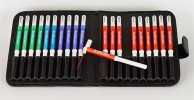Authors
M. Benbouzid, V. Pallage, M. Rajalu, E. Waltisperger, S. Doridot et al.
Lab
Université de Strasbourg, Institut des Neurosciences Cellulaires et Intégratives, Strasbourg, France
Journal
European Journal of Pain
Abstract
Because of its severity, chronicity, resistance to usual therapy and its consequences on quality of life, neuropathic pain represents a real clinical challenge. Fundamental research on this pathology uses metabolic, pharmacological or traumatic models in rodents that reproduce the characteristic human pain symptoms. In 1996, Mosconi and Kruger morphologically described a model of peripheral neuropathy in which a cuff of polyethylene tubing was placed around the sciatic nerve in rats. In the present study, we evaluated the behavioral consequences of this neuropathic pain model in C57Bl/6J mice which is the main genetic background used for studies in transgenic mice. A short cuff of polyethylene tubing was unilaterally placed around the main branch of the sciatic nerve. It induced an ipsilateral heat thermal hyperalgesia lasting around 3 weeks, and a sustained ipsilateral mechanical allodynia lasting at least 2 months. We showed that this neuropathic pain model is insensitive to ketoprofen, a non-steroidal anti-inflammatory drug. Morphine treatment acutely suppressed the mechanical allodynia, but tolerance to this effect rapidly developed. The analysis of video recordings revealed that most aspects of spontaneous behavior remained unaffected on the long term, excepted for a decrease in the time spent at social interaction for the neuropathic mice. Using the elevated plus-maze and the marble-burying test, we also showed that neuropathic mice develop an anxiety phenotype. Our data indicate that sciatic nerve cuffing in mice is a pertinent model for the study of nociceptive and emotional consequences of sustained neuropathic pain.
BIOSEB Instruments Used:
Von Frey Filaments (Bio-VF-M)

 Pain - Thermal Allodynia / Hyperalgesia
Pain - Thermal Allodynia / Hyperalgesia Pain - Spontaneous Pain - Postural Deficit
Pain - Spontaneous Pain - Postural Deficit Pain - Mechanical Allodynia / Hyperalgesia
Pain - Mechanical Allodynia / Hyperalgesia Learning/Memory - Attention - Addiction
Learning/Memory - Attention - Addiction Physiology & Respiratory Research
Physiology & Respiratory Research
 Pain
Pain Metabolism
Metabolism Motor control
Motor control Neurodegeneration
Neurodegeneration Cross-disciplinary subjects
Cross-disciplinary subjects Muscular system
Muscular system General activity
General activity Mood Disorders
Mood Disorders Other disorders
Other disorders Joints
Joints Central Nervous System (CNS)
Central Nervous System (CNS) Sensory system
Sensory system
